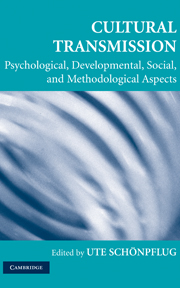Book contents
- Frontmatter
- Contents
- Foreword
- Contributors
- 1 Introduction to Cultural Transmission: Psychological, Developmental, Social, and Methodological Aspects
- 2 Theory and Research in Cultural Transmission: A Short History
- PART ONE EVOLUTIONARY PERSPECTIVE
- PART TWO CROSS-CULTURAL PERSPECTIVE
- 6 An Ecocultural Perspective on Cultural Transmission: The Family across Cultures
- 7 Intergenerational Relations and Cultural Transmission
- 8 Intergenerational Transmission, Social Capital, and Interethnic Contact in Immigrant Families
- 9 Developmental Processes Related to Intergenerational Transmission of Culture: Growing Up with Two Cultures
- 10 The Transmission Process: Mechanisms and Contexts
- 11 Accounting for Parent–Child Value Congruence: Theoretical Considerations and Empirical Evidence
- 12 Culture, Migration, and Family-Value Socialization: A Theoretical Model and Empirical Investigation with Russian-Immigrant Youth in Israel
- 13 Immigrant Parents' Age Expectations for the Development of Their Adolescent Offspring: Transmission Effects and Changes after Immigration
- PART THREE INTRACULTURAL VARIATIONS
- Index
- References
6 - An Ecocultural Perspective on Cultural Transmission: The Family across Cultures
Published online by Cambridge University Press: 05 June 2012
- Frontmatter
- Contents
- Foreword
- Contributors
- 1 Introduction to Cultural Transmission: Psychological, Developmental, Social, and Methodological Aspects
- 2 Theory and Research in Cultural Transmission: A Short History
- PART ONE EVOLUTIONARY PERSPECTIVE
- PART TWO CROSS-CULTURAL PERSPECTIVE
- 6 An Ecocultural Perspective on Cultural Transmission: The Family across Cultures
- 7 Intergenerational Relations and Cultural Transmission
- 8 Intergenerational Transmission, Social Capital, and Interethnic Contact in Immigrant Families
- 9 Developmental Processes Related to Intergenerational Transmission of Culture: Growing Up with Two Cultures
- 10 The Transmission Process: Mechanisms and Contexts
- 11 Accounting for Parent–Child Value Congruence: Theoretical Considerations and Empirical Evidence
- 12 Culture, Migration, and Family-Value Socialization: A Theoretical Model and Empirical Investigation with Russian-Immigrant Youth in Israel
- 13 Immigrant Parents' Age Expectations for the Development of Their Adolescent Offspring: Transmission Effects and Changes after Immigration
- PART THREE INTRACULTURAL VARIATIONS
- Index
- References
Summary
INTRODUCTION
Cross-cultural psychology attempts to understand how human behavior is shaped by the cultural context in which it developed. One approach to understanding this relationship is by examining the ecological and cultural settings in which individuals live and the patterns of behavior that emerge in them (Berry, 1976). To explain how a group's culture becomes incorporated in individual behavior, some form of linkage between them needs to be postulated. This connection is to be found in the process of cultural transmission (Cavalli-Sforza & Feldman, 1981), which is seen as the main link among groups of people (i.e., cultures, communities, and families) and the development of individuals (including their overt behaviors and the inferred characteristics that underlie their behavior). Within this process of cultural transmission, three subprocesses have been distinguished: enculturation, socialization, and acculturation (Berry, Poortinga, & Segall, 2002). The first is a general enfolding of the developing individual by one's cultural group, often without specific instruction; the second also takes place within a person's own cultural group but is usually accomplished by way of deliberate shaping (i.e., child-rearing practices) and formal instruction (i.e., education); however, the third results from cultural influences arriving from outside a person's own culture, typically involving both enfolding as for enculturation (e.g., by mass telemedia) and deliberate changing as for socialization (e.g., by formal schooling).
- Type
- Chapter
- Information
- Cultural TransmissionPsychological, Developmental, Social, and Methodological Aspects, pp. 95 - 125Publisher: Cambridge University PressPrint publication year: 2008
References
- 6
- Cited by



